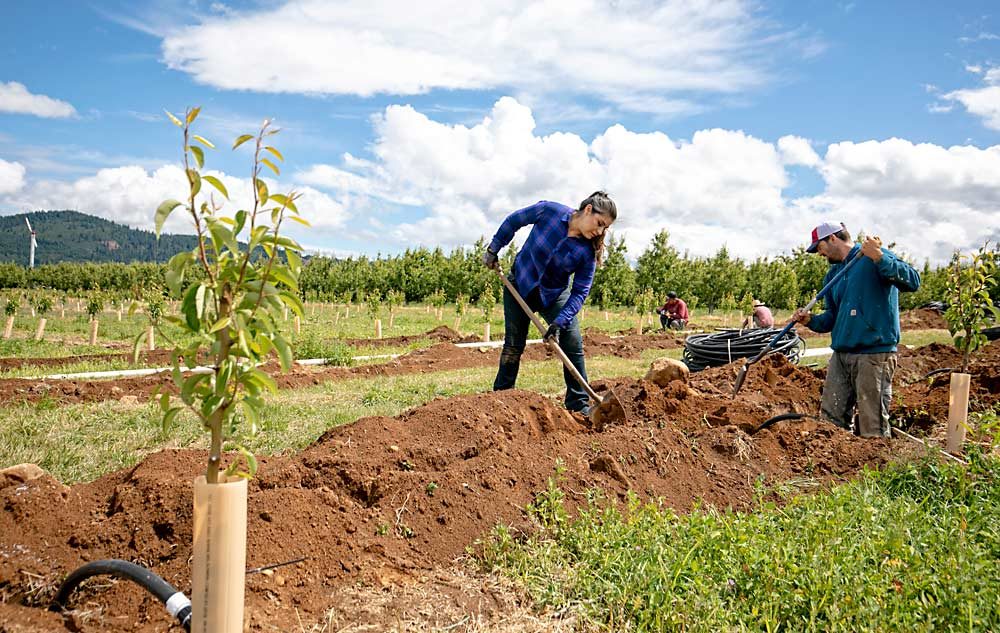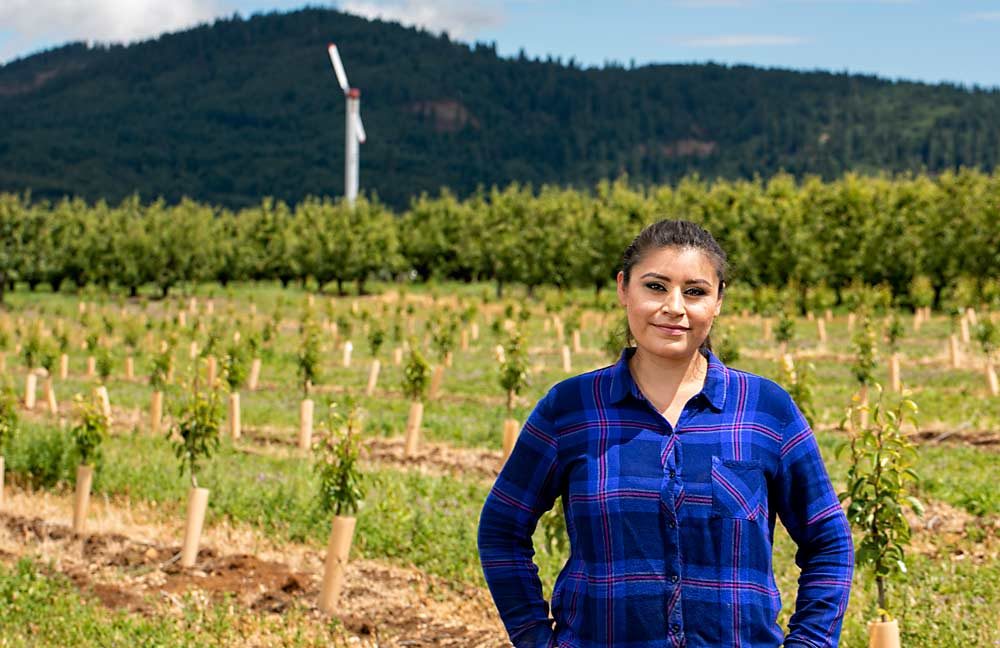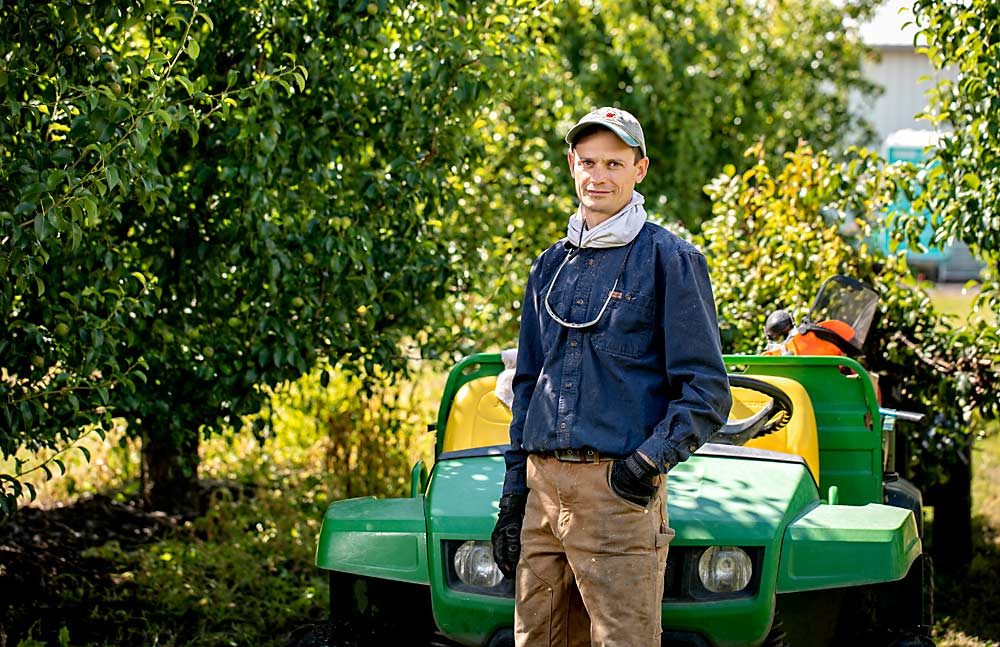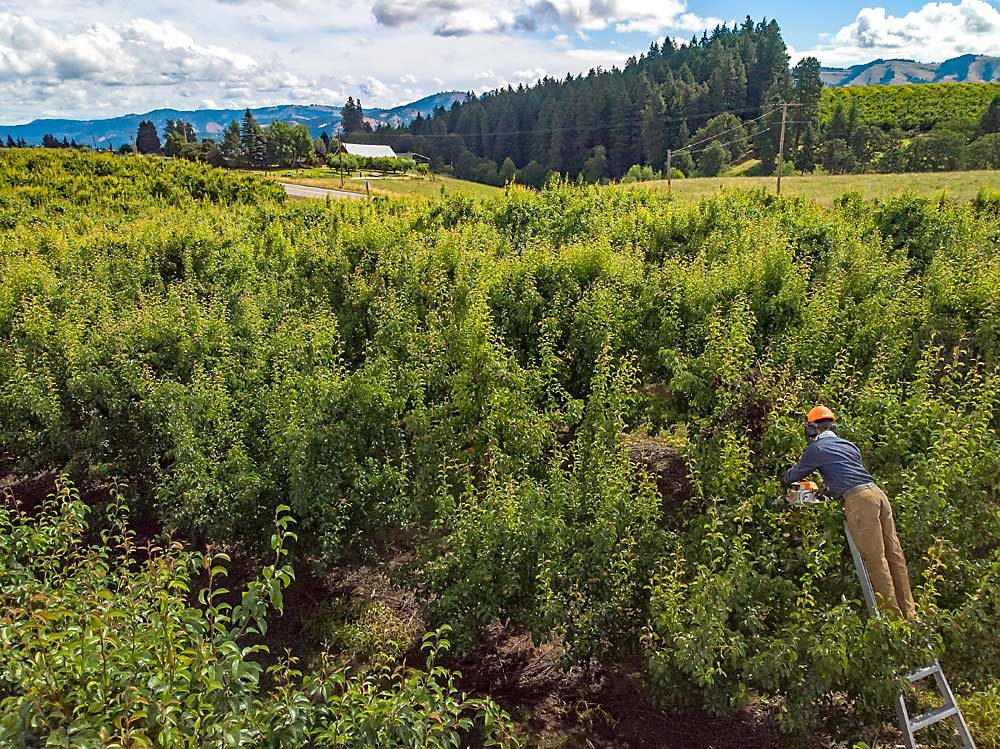
It’s long been said in the Northwest fruit industry that you plant pears for your heirs.
But to young pear farmers today, it doesn’t ring true anymore: Falling prices and stagnant domestic demand make it difficult to feel confident investing in orchards for the future.
“How long can we, as growers, afford to be here?” asked Yesenia Sanchez Oates, who farms with her husband in Hood River, Oregon. “It costs $240 to grow a quality bin of Anjous that sells for $180. How many years can we go losing this much money?”
Sanchez Oates was one of many growers who spoke out at the Pear Bureau Northwest’s annual meeting in May, urging board members and industry leaders to make changes to ensure that all the pears shipped to domestic consumers meet quality standards. Too many pears that don’t ripen soon enough — or at all — have discouraged consumers from coming back to buy more.
It’s not a new conversation for the pear industry, but the urgency is increasing. Discussion at the annual meeting revealed that there is broad consensus on the problems, but some of the proposed solutions, including the idea of changing the marketing order to self-regulate, remain controversial.
“There is absolutely a sense of urgency. The price levels the past couple years with historically short crops are not sustainable,” said Ed Weathers, president of pear packer Duckwall Fruit and officer on the Pear Bureau’s Fresh Pear Committee. “We’ve hurt ourselves in the misuse of 1-MCP and we’re being squeezed by a plethora of other items that are ready-to-eat on the shelves. All these things have converged to a point of now we are at a nonsustainable price level.”
Weathers worked on an industry task force convened over the past year to discuss the confluence of critical issues facing the domestic fresh pear market. The group shared findings on 1-MCP (1-methylcyclopropene), preripening, packaging and potential changes to the marketing order at the May meeting in Portland, Oregon.
Rescuing the pear category from its current trajectory is a complex proposition that likely requires changes in growing practices, postharvest handling and marketing. But there are signs of positive steps forward, with shippers investing in new conditioning capacity, a few major retailers deciding to insist on conditioned pears, and a new USAPears marketing campaign promoting preripened Anjou as the “new variety” in the pear category.
“I thought it was actually brilliant, the ripe Anjou as the new variety. Pear production and pear varieties have not changed, they are slow to come in to production and there’s a lot of reluctance to change,” Weathers said, adding that the industry needs to work with what’s in the ground now. “The ripe Anjou message is a good one because what it really comes down to is providing customers with a better experience.”

Problem pears
It’s hard to beat a perfectly ripe pear. It can also be hard to find one.
“I’m a pear grower and even I have a hard time picking pears at the grocery store,” said Russell Dichter, a Hood River pear grower. “It impacts all growers when consumers bite into a pear and are disappointed.”
Consumers want a pear they can eat one to three days after purchase, said Kevin Moffitt, president and CEO of the Pear Bureau.
“Pears have a wonderful flavor profile that can distinguish them, but a lot of fruit has been shipped fairly green, arriving green, and consumers were passing them by because they weren’t ready to eat or were eating them before they were full of flavor,” he said. “Consumers don’t want to gamble on ripeness.”
Those unripe pears result from several issues: misuse of 1-MCP to hold late-season fruit, delaying ripening too much or stalling it entirely; lack of conditioning; and Anjous that are marketed too early, before they’ve had the cold storage time necessary to activate their ripening process.
Fruit produces the hormone ethylene, which drives ripening. To extend the storage season, many pome fruit packers have turned to 1-MCP, which is similar to ethylene and blocks its receptors to temporarily suppress the ripening process.
It’s worked well for apples, with extensive use recommendations and protocols developed over the past 16 years. But in pears, which need the ripening process to resume, it’s been much more challenging to achieve ideal results.
The industry has made significant changes in the past few years, recognizing the risks of overapplication and reducing its use in the domestic market, said Ray Schmitten, a longtime grower and horticulturist for Blue Star Growers who has been compiling data on 1-MCP use in the pear industry for the task force.
“It was self-evident that 1-MCP was a factor and a lot of warehouses slowed down or completely quit using it,” he said. “I commend the warehouses that have eliminated 1-MCP and support the warehouses that are learning how it works and reducing their use of it.”
To extend the pear season without relying on 1-MCP required making some changes to really dial in strict cold storage procedures, but it’s paying off in terms of quality, said Mike Parrish, a task force member who also represents Stemilt Growers on the bureau’s Fresh Pear Committee.
The improvement focus needs to be on the early- and late-season pears, he said. It’s pretty easy to ship ripe, flavorful pears in February, March and April.
“If we have 15 percent on the front end and 15 percent on the back end that just aren’t going to be real good, that’s a third right there,” Parrish said. “To me, that’s an opportunity the pear industry has: to be better.”
Growers, too, have a role to play, as fruit produced by big, old trees tends to be more inconsistent in terms of maturity than fruit produced in a more uniform, fruiting wall-type canopy, but with low prices, it’s hard to afford to pick in multiple passes or invest in new plantings.
“As growers, we need to be modernizing our orchards,” Dichter said, for both fruit quality and labor reasons. “Older farmers say it’s always worked fine so why change, but I guess I am a young grower and I have to look to the future because we are really hitting the bottom.”
That’s all true, but the top industry priority should be improving the market for the trees in the ground, Schmitten said, and reducing the costs of labor and pest control.
“We’re going to have to really improve our product to the consumer. That means ripe pears, sliced pears, you name it,” he said. The Northwest’s expected production of more than 9.5 million boxes of Anjou is ripe for improvement. “We’ve sold a lot of green, hard pears. There’s a lot of room for a consumer to enjoy a ripe, sweet, juicy pear.”

Ready ripe
That’s where conditioning comes in. The concept is certainly not new, but packers and retailers have initiated a renewed push for conditioning to provide consumers better quality fruit that calls them to buy more.
“The idea of bringing out the flavor fully is one way for pears to compete,” Moffitt said. He’s promoted it for years, encouraging retailers to adopt conditioning plans for pears alongside bananas and avocados, but some shippers have been reluctant to invest in more conditioning capacity until customers asked for it.
This year, that’s changing. The Pear Bureau is promoting “ripe Anjou is the new pear variety” to push the issue of conditioning onto shippers and customers alike.
A few major retailers have also opted to only buy conditioned fruit this year, and plan to keep holdback samples to ensure each lot of fruit ripens in the expected timeframe. Those retailers also plan to share data back with shippers, which they hope will show that conditioning does pay off in terms of consumer demand.
“We’ve been talking about it and talking about it and I think if we start measuring it, then we’ll start improving it,” Parrish said.
Pears typically begin to ripen on their own internal clock after a period of cold storage, but ethylene conditioning in a warm room can trigger the start of that process more uniformly across a lot of fruit. Fruit is then cooled back off for shipping, ready to ripen in just a few days when it hits a warm store shelf or kitchen countertop.
It works well, especially with new technology to calibrate the process, but challenges remain for scaling up the industry’s conditioning capacity to the level many believe is needed.
One problem is the financial investment in state-of-the-art conditioning capacity, and another is that the typical packaging carton for Northwest pears lacks good airflow to make conditioning work. Switching to a tray pack, and working with retailers to accept that, would make a big difference. The time it takes to condition can also create logistical challenges with last-minute orders.
At the May meeting, some expressed concern that the industry was getting ahead of itself, promoting ripe pears without enough capacity to provide them. Moffitt said it’s realistic to expect to see 40 to 50 percent of the Anjous conditioned in the next few years, but it’s not going to happen overnight.
“I am skeptical we have the capacity to do it all this year, but optimistic we as an industry will continue to spend money to make it happen,” Weathers said.
As the industry catches up, there’s cooperation growing as well, with packers that have more capacity conditioning fruit for others in need, Schmitten said. That sort of industry cooperation on ripening and fruit quality, not competition, is going to be critical for the future of pears, according to many sources for this story.

Self-regulation
Even top-notch conditioning can’t reliably ripen Anjous the first few weeks after harvest. They need at least a month in cold storage to settle down after picking, before they can ripen well.
That’s why some growers called for changing the industry’s marketing order to prevent early-season Anjou sales. It’s a controversial idea because shippers don’t like the idea of tying their own hands when they already have an oversupply to market.
From a fruit quality standpoint, the fall is the time to market Bartlett, not Anjou, but grocery stores often want a variety on display.
“When you have good Bartletts, why mess with it with a questionable Anjou? Let’s do well on Bartletts and have the Anjous piggyback on that.” Parrish said. “We have to work with our retailers to turn off that Anjou trigger and get them to change that mindset, too.”
Working with retailers to make the change, rather than regulating through the marketing order, was the preference of some board members, although several also acknowledged that the let-the-market-handle-it approach is what led to the current state of affairs for pears.
“What we’ve shown as an industry is that we don’t have a lot of self-control. We all agree what we are doing wrong, but we can’t control it, so let’s put some rules in place to control ourselves,” Weathers said, adding that as a free-market guy, the idea still makes him uncomfortable. “I don’t think it’s a cure-all. But if our goal is to provide a better eating experience for our customers, it’s just as worthy as the reduction of the misuse of 1-MCP.”
No decisions were made at the May meeting, but Weathers said he planned to continue the discussions into the fall so decisions could be made in the coming year.
“All this is coming rather rapidly, but we don’t want to make a decision on a marketing order without due diligence,” Don Gibson, president of the Mt. Adams Orchards Corp., and a Pear Bureau Northwest board member, said at the May meeting. “I feel like we want to vote on something because we are desperate, but we’ve got to get it right.” •
—by Kate Prengaman






Leave A Comment